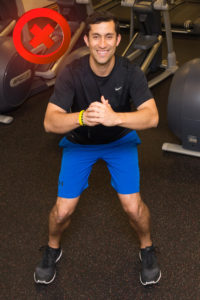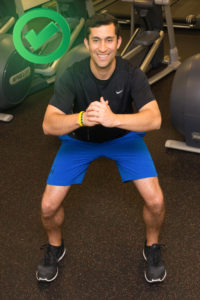When exercising, it is important to complete each movement properly and understand what muscles should be working.
The squat is the foundation of most workouts. Whether you are lifting legs, taking an exercise class or even running (yes, running), the squat is either involved or will help you better perform the exercise you are completing. The movement patterns used for a squat are often used in more complex exercises, so it is important to perfect the squat to help you perform your best.
Before beginning the movement, let’s review the benefits of squatting and the main muscle groups being used.
Benefits:
- Increases your lower body strength
- Increases your bone and joint strength
- Increases your resilience and flexibility
- Helps strengthen and properly engage your postural muscles
- Helps develop a strong core
- Helps joints move and feel healthier
Main muscles used during squats:
- Quadriceps
- Hamstrings
- Gluteus muscles
- Abdominal and core muscles
- Back flexors and extensors
- Smaller intrinsic muscles that help stabilize the ankles, knees, hips, back and shoulders
As you can see, there is a lot going on with the squat. When done correctly, it can engage many muscles throughout the body. Now that you understand the why, let’s explore the how.
A squat can be performed with or without weight but should first be perfected without weight. When learning to squat, flexibility and basic strength in your joints and muscles are key. Before squatting, make sure you take the time to warm up your lower body, core and back with some stretching and light movement.
When performing a squat, it is important to follow the below steps to ensure you are engaging the correct muscles and keeping your joints and ligaments safe.
- Foot stance: Create a wide stance, slightly wider than shoulder-width apart, with your toes turned out a bit and your feet completely flat on the ground. You may need to play with your foot positioning to find what feels right for you. Imagine your big toe, little toe and heel pressed firmly into the ground — this will ensure you have active feet throughout the squat.
- Create natural posture: Stand tall, fill your belly with air as if you are pushing against something, keep a proud chest and look forward. These steps will assist with maintaining an active core!
Time to initiate your squat:
- Sit back: Imagine a chair behind you, and try to sit in it. As you sit your hips down and back, allow your knees to naturally bend towards your toes.
- Keep your feet flat: Keep feet firm and flat to the floor.
- Drive your knees out wide: Don’t let your knees cave in toward each other. Drive them out wide so you feel your feet and hips engage even more.
- Keep your back neutral: Keep your neck and spine in a straight, neutral position. Make sure you are looking forward and not angling your chin up or down.
Bottom of squat ⇒ standing
- Drive your feet through the floor: Keep your feet flat, push through your heels and stand up as if you are pushing the ground away from you. Explode upward!
- Engage your glutes: Imagine someone is lifting you up.
- Engage your core: Actively breathe out to help support your back and keep your core tight.


As you move through the above steps, remember to take time to change up your stance. Think about narrowing or widening your stance, and see what feels more natural and effective. There is no right or wrong squat stance; everyone is built and moves differently.
Take your time when performing a squat, and make sure you practice with no weight. When you begin to feel more comfortable, add a kettlebell or a dumbbell for some more weight. Pay attention to your form, and make sure you are still going through the above steps. Let the squat help you explode into your next exercise routine with power and endurance!
By: Alexandra Hoppman

